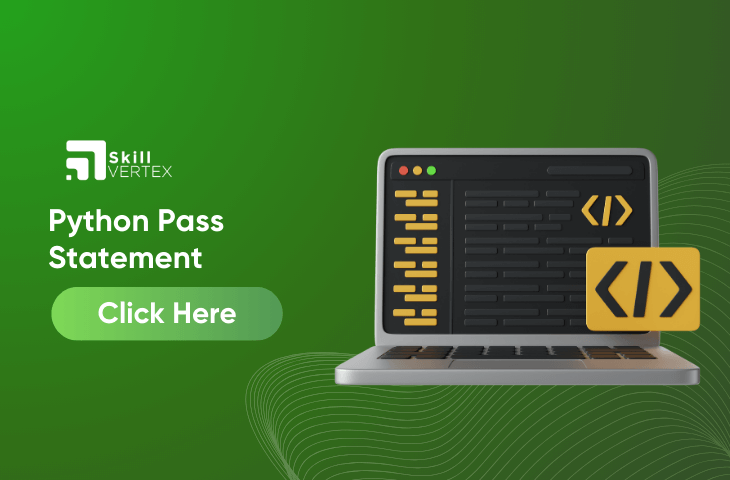Table of Contents
In Python, the pass statement is referred to as a null statement. However, the pass statement won’t be neglected by the interpreter. This article has listed the pass statement in Python
What is a Pass Statement in Python?
The user will pass the line only when they don’t know what code to write. This indicates that the pass will be performed when the user doesn’t need any code to run. The empty codes are restricted from placing the pass that works similarly to the loop, function definition, or if statements. Thus, the Pass statement user will avoid this error.
What is the Syntax of the pass statement?
pass
What are the examples of the Python Pass Statement?
Example 1: Use of Pass Keyword in Function
def example_function():
print("Inside the function")
pass # Placeholder for future code or intentionally doing nothing
print("Still inside the function")
# Call the function
example_function()
Output
Inside the function
Still inside the function
Example 2: Use of Pass Keyword in Python Loop
for i in range(5):
if i == 2:
print("Skipping iteration 2 using pass")
pass # Skip the rest of the code in this iteration
print("Iteration:", i)
print("Loop finished")
Output
Iteration: 0
Iteration: 1
Skipping iteration 2 using pass
Iteration: 2
Iteration: 3
Iteration: 4
Loop finished
Example 3: Pass Keyword in Conditional statement
x = 10
if x > 5:
print("x is greater than 5")
# Some code here
pass # Placeholder for future code or intentionally doing nothing
else:
print("x is not greater than 5")
# Some other code here
print("Conditional statement finished")
Output
x is greater than 5
Conditional statement finished
Note
In all the codes, it is important to keep in mind that the colon will follow the pass statement (:) to mention the beginning of the code block, and thus no code will appear inside the block. Due to this, it is referred to as a placeholder statement.
Example 4: Use the pass as a Place holder inside the if statement
x = 7
if x > 5:
print("x is greater than 5")
# Some code here
pass # Placeholder for future code or intentionally doing nothing
else:
print("x is not greater than 5")
# Some other code here
print("Conditional statement finished")
Output
x is greater than 5
Conditional statement finished
Conclusion
In conclusion, the pass statement in Python serves as a no-operation placeholder, allowing the creation of syntactically correct code structures without introducing any specific functionality. It is particularly useful in scenarios where a code block is required by the syntax, but the implementation is intentionally left blank or deferred for future development.
However, The pass statement is often employed in functions, loops, or conditional statements as a convenient way to outline the structure of the code without introducing any specific actions. Its simplicity and readability make it a valuable tool for developers when crafting modular and flexible code.
Python Pass Statement- FAQs
Q1. What is a pass statement in Python?
Ans. The Pass statement will function as the placeholder for future codes.
Q2. What is class and pass in Python?
Ans. The class is named DontAppend and you will use the pass statement inside it, the class block becomes valid, even though it doesn’t do anything specific. It’s like creating an empty container that follows the rules of a class but doesn’t have any special actions.
Q3. Is pass a null operation in Python?
Ans. No, Pass is referred to as the null statement.
Hello, I’m Hridhya Manoj. I’m passionate about technology and its ever-evolving landscape. With a deep love for writing and a curious mind, I enjoy translating complex concepts into understandable, engaging content. Let’s explore the world of tech together

